navjeevanexpress.com invites research articles from academic experts to give wings of fires to its discerning readers: R Arivanantham, Executive Editor. Articles can be mailed to navjeevanexpress@gmail.com, manickavasagam1959@yahoo.co.in

RAMYA
Chhattisgarh State is a gold mine of fascinating tribal culture in Central India. It has been a treasure trove yet to be explored and discovered. It thrives on the cultural magnitudes and myriads of age- old traditions and rituals that are yet to be told. Whether it is the exclusive handicrafts, wild rivers, quaint villages, ancestral temples, rich tribal cultures, ancient monuments, historical cities, unique festivals, the saga of the royal palace, the wilderness of the natural parks or forgotten tales of dense forest in Bastar, Chhattisgarh is a land full of surprises and many possibilities. It is a potpourri of countless attractions. Seeing everything with your own naked eyes will be endlessly rewarding.
Meet Archana Soreng, representing Kharia Tribe from #Odisha
& a member of the @UN Secretary General’s Youth Advisory Group on #ClimateChange.
Ahead of #IndigenousDay, she talks abt role of indigenous women
in biodiversity conservation.#WeAreIndigenous@TribalAffairsIn pic.twitter.com/k4xwGmOuqT
— UNDP India (@UNDP_India) August 8, 2023
The International Day of the World’s Indigenous Peoples, or the World Tribal Day, observed on August 9 each year.
- Bastar is popularly known for Bison Horn Maria, Abhuj Maria, Muria, Bhatra, Dhuruva, Halba, Dorla and Gond tribal communities
- Each tribal group of this area has its own culture that stands apart from the rest
- One of the famous delicacies is the Chapura-The Red Ant Chutney
- The purpose of the Ghotul culture is not just to find the potential life partner, but they are given an exclusive time to know each other before the big commitment
- Tribals have a separate ceremony where women participate to draw tattoos on the bride’s body before the wedding
Bastar is a well kept secret of Chhattisgarh and biggest tribal district of the state. Bastar flaunts dense forests, hidden caves, unique festivals, and incredibly simple tribal people with their rich cultural heritage. Home to almost 40 tribal communities, Bastar is popularly known for Bison Horn Maria, Abhuj Maria, Muria, Bhatra, Dhuruva, Halba, Dorla and Gond tribal communities. The Bastar region starts from the Kanker district, though the tribal settlement starts beyond Keshkal Valley which leads Kondagon and Narayanpur.
Glimpses of ‘𝑻𝙧𝒊𝙗𝒂𝙡 𝘼𝒓𝙩𝒊𝙨𝒂𝙣 𝙚𝒎𝙥𝒂𝙣𝒆𝙡𝒎𝙚𝒏𝙩 𝙈𝒆𝙡𝒂’ (𝑻𝘼𝒆𝙈) organized by TRIFED South at Attapadi,Palakkad district, Kerala today for empanelment of Tribal artisans in the district, to showcase their products for empanelment with TRIFED. #Vocal4Local pic.twitter.com/42hdAwLIRy
— TRIFED South (@TrifedSouth) August 9, 2023
Tribal culture of Bastar showcases a unique tribal heritage and culture across the world. Each tribal group of this area has its own culture that stands apart from the rest. Every tribes of Bastar also enjoys a unique traditional living style. The dialects of these tribes differ from each other as do their traditions, eating habits and costumes. They worship different forms of Gods and Goddesses.
Gonds Tribe
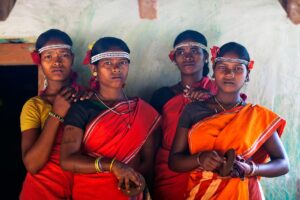
The Gonds recognized as Koytorias/Kotoriya tribe mainly predominates the forest of Bastar. Some believe they are the oldest tribe of the world. The Gonds are uniquely known in India due to their Ghotul system of marriage. The Ghotul system is related to Goddess Lingopan. Lingo, the supreme deity created the first Ghotul.
Also Read:
Gonds are the largest tribe in terms of population. The economy of the tribal people is dependent on works like forestry, hunting, fisheries and cottage industries. They mainly practice Hindu customs and marry within the family. Gond society is matriarchal where the groom pays dowry to the bride to pay due respects. They live in small villages with special skills which they pass down to their generation and use plants and herbs for curing and medicinal purposes.
The three sub castes of the aboriginal Gond tribe are the Dorla, Maria and Muria races.
Madia Tribe

The word Madia originated from the word Mad of Gondi dialect which means hills. Thus Madia are the people who live in the hills. In the mountains of Abujhmad, spreading across Narayanpur, Bijapur and Dantewada live the Maria tribes of Bastar.
They have coppery complexion with straight black hair, wide mouth and thick lips. The women are graceful, light in complexion and wear exotic jewelry made of canes, grass and bead.
Both boys and girls are allowed to spend the night out at the Ghotul, a house just like others. As per the tradition, the unmarried boys learn song and dance from their masters, sleeps in Ghotuls every week. The dance is also performed by the girls as well. It is like a pilgrimage.
Goddess Danteswari is the reigning deity of the Marias with an abundant respect for black magic as well.
Halbaas Tribe

They are mainly farmers and are not only found in Bastar but they are spread in Madhya Pradesh, Odisha and Maharashtra States. They speak Halbi dialect which is a language the king of Bastar used to speak. Halbas of Bastar believe that their ancestors were from Warangal with Raja Anam Dev.
The origin of the word Halba is from the word Hal meaning plough and thus known as Halba.
Dhurvaa Tribe

These tribes are found in the Adhar and Chintgarh areas of Bastar who are known for their bravery. The clothing style, hair style, jewelry and everything on a woman’s body distinguish them from the others. The tribe has given birth to warrior Gunnadadhur who led the tribal community in 1910.
The Dhurvas are proud, courageous and highly caste conscious race who mix with people of equal social standing. They are religious and worship the village Goddesses with a marital system just like other tribes. Tobacco and liquor consumption is a must during celebrations and activities and are consumed by both men and women, young and old.
Dhurva community celebrates a festival known as Gurgal for one month continuously every year which is known for its musical importance.
Dolra Tribe
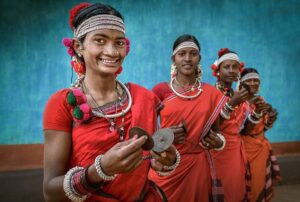
The people of this tribe are mainly found in the areas of Konta and Bhopalpatnam of Bastar. Their dialect is Dorli influenced by the Telugu language. Their ancestors are also from Warangal. Dorla community has affinity with cows and pays much respect to deity Bheema Dev.
Muria Tribe
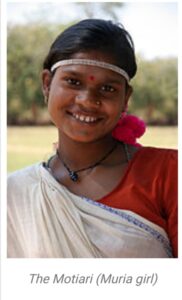
The word Mur is a Sanskrit word meaning Mool which is the root. It denotes the first inhabitants. The Murias are neat, industrious and good cultivators who constitute the major block of the population. The Muria economy is agrarian and they cultivate rice in plenty. Some of them are also dependent on collecting forest products and edible parts are consumed by the poverty ridden tribals.
The Muria society is devoid of caste system and practice magic and wizardry and believe worshipping cult Gods and Goddesses.
Tribal Food

Food in Bastar has a very distinctive flavor. They have a variety of cuisines, mostly made out of ingredients found in the wild. One of the most popular delicacies from the land of Bastar is the Chapura-The Red Ant Chutney. Apart from that, the locally brewed drink Mahua, made of the wild flower. A snack made of rice and lentil fried called Bobo, dessert called Soju, made of jaggery-sweetened dessert that looks like a Barfi. Women selling the beverages in the weekly haat (market) and equally enjoying the drinks, as this are essential to their tribal menu. Some of the prominent drinks are Mahua, Salphi, Landa and Rasum.
The Ghotul Culture
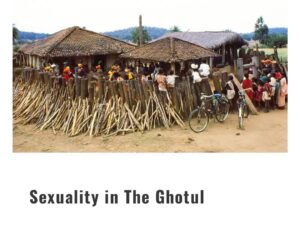
The Ghotul culture is an integral part of Muria tribal life. It is often misunderstood by the outsiders, considering it as a place of debauchery. In reality, Ghotul is social arrangement for the Cheliks (unmarried boys) and Motiaris (unmarried girls) who are encouraged to go to the exclusive living space where they meet, greet, dance, sing and spend nights together in an earthen and wooden hut at the outskirt of the village. The purpose of the Ghotul culture is not just to find the potential life partner, but they are given an exclusive time to know each other before the big commitment. In Ghotul, they learn about various tribal customs, rituals, social responsibilities, various life-saving skills and are also taught about sexuality.
The young women and men, after finishing their household work, go to Ghotul. Everyone wears their best attires. Women adorn the beautiful traditional sari, decorated bun with Mahua flower, traditional jewelry and headgear which enhances the beauty. The Ghotul culture is an indispensable part of the Muria way of life. They believe that the Lingo, their supreme deity, created the first Ghotul.
According to Dr. Verrier Elwin, “The Ghotul was not just a club, but a place where freedom and happiness were treasured. Sympathy, friendliness, unity and hospitality were of primary importance. Love was beautiful, clean and precious and sex was a part of life. Today, Ghotuls are fast disappearing”.
On deciding upon the prospective groom and bride, the respective parents are informed about the decision. Eventually, it leads to marriage. At weddings in Bastar, there is “Reverse Dowry” system where the groom family has to offer dowry to the bride’s family before marriage. However, the dowry doesn’t follow the traditional Indian footsteps; rather they offer Mahua drinks, rice, goats and sometimes Mahua flowers as dowry.
The Ghotul culture celebrates a great sense of liberation. It is almost unlikely to believe that a community living in the middle of dense forest, far away from the spell of modernity, is practicing a system which is way forward in comparison to the so-called modern folks who are living in the metro cities with closed minds.
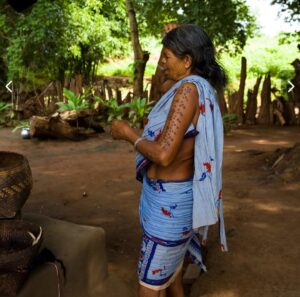
Tattoo is one of the most important parts of Cultural Identity of Tribal Communities in Bastar. The tribal communities can be identified by their tattoo art on their body. Each tribal community has a distinctive way of making a tattoo. It is a part of their lifestyle and considered very important. They believe that the bride needs to have tattoos on her body before the marriage. Traditionally, if a woman does not have tattoos, her parents have to pay a huge dowry to the groom’s family.
The tattoos are not just considered as body art here, but it has a way deeper meaning to it. They believe that tattoo art enhances the beauty of the bride and it is better than any jewelry. The tattoo art on the body is considered as permanent jewelry which one takes along in the journey of the afterlife. According to their tradition, tattoos are essential for woman to gain entry into the heaven. They have a separate ceremony where women participate to draw tattoos on the bride’s body before the wedding. The tribal women look stunning with the striking body art.
Art & Craft of Bastar

Bastar’s villages are also known for their finest craftsmen and their excellent work of art. Paintings inspired by the tattoo arts, bell metal sculptures, wrought iron figurines, weaving, terracotta & clay work, Gonda art, this region is rich with art and craft. Their products have reached far away countries as it is being exported internationally as well.
The signature craft of Bastar is Dhokra. It is an ancient method of metal casting which have been passed down through generations. It is said that this art dates back to more than 4000 years. This unique piece of art has become the recognized identity for Bastar. They are also known for slim iron figurines which are crafted with a wrought iron. Using this technique, they create mirror frames, iron wall hanging, candle stand and many more. Terracotta or Clay work is another craft that Bastar is known for. Weaving, tribal paintings, Kosha silk, stone sculptors are remarkable from this part of the region as well.
Festivals of Bastar
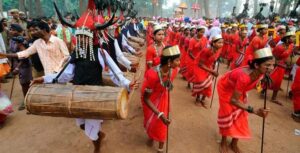
The Bastar Dusshera is the most prominent festival of this part of the state of Chhattisgarh. It is the longest festival of the world which goes on for 75 days. Bastar Dusshera is celebrated in honor of the local deity “Shri Danteshwari Mai” and was started almost 800 years back. The whole Jagdalpur comes to life with vibrant colors and various festivities during 75 days of grand celebration. The festival starts in July and continues till October. Thousands of Adivasis from all across Chhattisgarh participate in the festival rituals, especially in the last ten days.
Haat (Market Place)
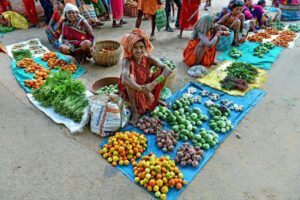
Weekly Haats are held in every village wherein small to big stuffs are sold by the tribes in order to earn a living. The local people come to the Haat to enjoy and spend some time buying and having fun. One can even try the local snacks that are sold. Exclusive items like local liquor made from dried mahua flower, rice bear/landa, salphi are the items mostly found here in plenty.
They bring their handmade craft to the Haats for better prices. Cock fight is a regular scene to watch here.
Frog Marriage

Dorlas are famous in celebrating marriage feats of frogs to get sufficient rains known as “kappal pandum.” It is celebrated by the women where a date is fixed by the priest and the ladies collects frogs from the field and keeps them in a new pot. This pot is covered with a new cloth as well. The pots are then taken to the village head’s house and kept for almost a week after which they are taken in a procession and left to the nearby stream and ponds.
During the occasion the aged women pay special homage to the clan God.
Dance
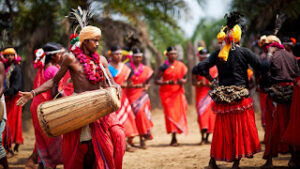
From birth to death and in every step of life, dance is inseparable part of the tribes. Use of colorful costumes, ornaments and headgear are important characteristics of the tribal dance. To add more charm, gungroos and bells are tied to the body which creates a musical sound.
Collective dancing is a part of the tribal culture with some of the famous forms being,
Madia/Maria – Karsad, Gaur
Muria – Halki, Mandri, Gedi
Gond – Bilma, Fag
Baiga – Fag
Dorla – Dorla
Several Bastar Tribes are still living amidst deep forest. The tribal people have their own rules and regulations and women wearing attire which is very different and colorful. Their jewels are made of beads and metals. It is the rarest of conserved culture of the primitive man. The tribal beauty and the age old Indian culture is really mesmerizing. Bastar is true representation of tribal ancient lifestyle, which is yet to be explored.
(The author of this article, Ramya is an Assistant Professor & Tribal Researcher in the Department of English, PKR Arts College for Women, Erode District, Tamil Nadu. She can be reached by mail ramyaindia1947@gmail.com)












